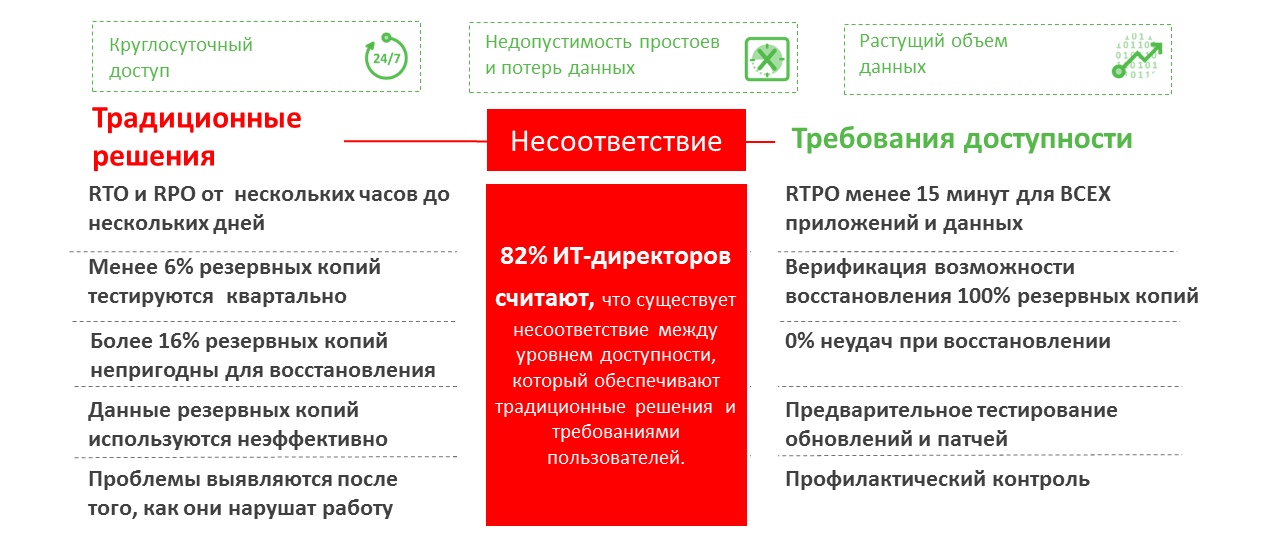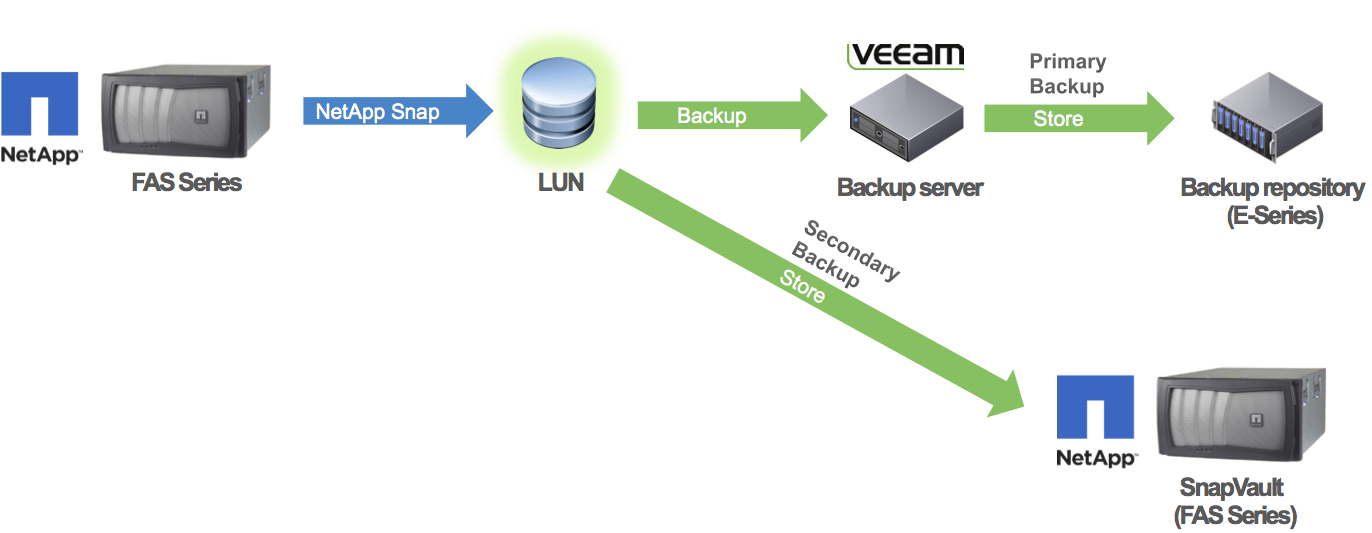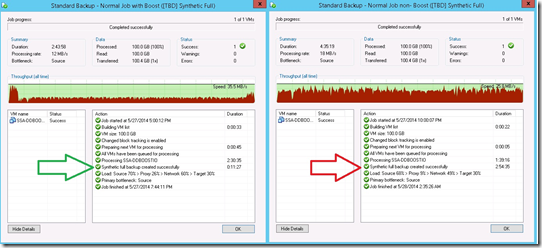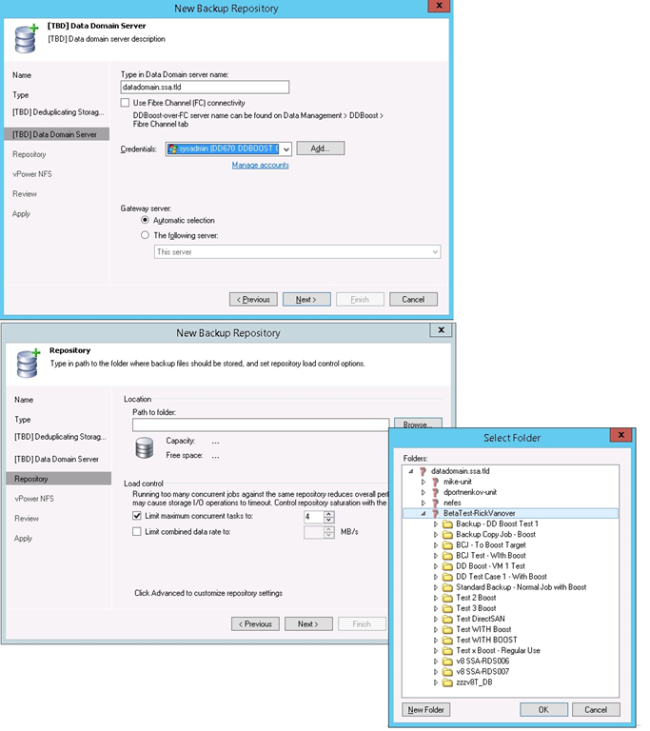Veeam Backup & Replication v8 Released (Paid and Free Editions)

A new version of Veeam Backup & Replication v8 was released last week, and in this article I will describe the new features that have appeared in it, as well as which of this new functionality is available in the free edition of the product.
NetApp Hardware Snapshot Support
With Veeam Backup & Replication v8.0, backups and replicas of virtual machines can be created using NetApp storage hardware snapshots. A similar approach was already implemented in previous versions for such high-end storage systems as HP StoreServ (3PAR), HP StoreVirtual (LeftHand / P4000) and HP StoreVirtual VSA.

Let me remind you of the advantages of hardware storage snapshots. The technology of hardware disk images has long been designated by experts as a technology that can drastically reduce RPO (the maximum time during which new or changed data remains unprotected from failure, that is, not duplicated to a backup). The essence of the technology is that the storage system independently, with adjustable frequency, creates snapshots of its disks. Since the developers of storage systems know better than anyone else the design of their disks at a low level, it is obvious that they can also create snapshots of such disks with the maximum level of efficiency and productivity - that is, with the least impact on a productive system. Therefore, hardware snapshots are a good source of backups.
At the same time, hardware snapshots themselves cannot be considered as a reliable way to protect data from failures, primarily because snapshots are located on the same storage system that they “reserve”. In the event of a failure on the storage system, it is highly likely that both the original data and their snapshots will be destroyed. In order to ensure proper reliability of data protection from failures, it is necessary to move data backups to a different location relative to their original storage location.
In addition, snapshots have a number of disadvantages:
- hardware snapshots use the useful capacity of the original disk , and their total maximum size is dictated not only by data protection requirements, but by the "counter" requirements of business applications of a productive system. Therefore, the second urgent task is the timely removal of old snapshots. Moreover, due to the peculiarities of the algorithms used, the presence of a large number of old snapshots in some cases can slow down or even lead to malfunctioning of some applications whose data is located on the storage system. Veeam Backup & Replication allows you to simply solve this problem, as it “holds a snapshot” on the storage system only until its data has been moved to a backup copy, after which the snapshot is automatically deleted.
- the recovery procedure from the hardware snapshot is not granular (if necessary, restore a separate file to the storage, as a result of restoring the disk from the hardware image, the entire storage is “moved to the past" and the last changes to the disk are lost),
- hardware snapshots may turn out to be “crash-consistent” - since storage systems may have limitations on Application Aware backups, and it can back up without first flushing application buffers in memory to disk, since in general the storage hardware has complete information about the nature of the data (about the type of operating system, about the type of disks: virtual or physical disks, about the type of applications, etc.) stored on it.
As a consequence of the above, it is quite reasonable to combine the functionality of the backup product and the functionality of hardware snapshots built into common storage systems, since they complement each other well.
You can read more about NetApp support in our article on Habr “Support for hardware snapshots of NetApp storage in Veeam Backup & Replication v8”
EMC Data Domain Boost Support
The integration of Veeam Backup & Replication v8 and EMC Data Domain Boost has significantly accelerated the process of building full synthetic backups (when each new incremental or differential backup is immediately used to rebuild a full copy of the data in the storage, which significantly reduces the recovery time), as well as the backup process copying in general. This is made possible by the advanced EMC Data Domain Boost deduplication functionality:
- firstly, the backup process is accelerated by the use of deduplication technology on both sides when transmitting data over the network (the amount of physically transmitted data is significantly reduced),
- secondly, building full synthetic backups to storage with built-in deduplication enabled is faster because data on the disk moves logically, but not physically.
For example, in one experiment we conducted to create a full synthetic copy of a test virtual machine, the time taken to complete the task was less than 11.5 minutes when starting from EMC Data Domain Boost, and almost 3 hours when starting a task with deduplication turned off. The difference in speed was about 15 times!

Of course, each specific virtual infrastructure is unique in its characteristics, and the gain from deduplication on a particular virtual machine will greatly depend on the nature and intensity of data changes on its disk.
And even if you prefer a normal full backup to a synthetic one, you will benefit from deduplication of network traffic: data blocks that were previously transferred to the storage side will not be transferred over the network in further full copies. This is clearly seen in the two pictures below (they reflect the network load when building the first incremental copy). In the picture on the left, traffic deduplication is turned on (EMC Data Domain Boost), and on the right - off.

Which is better: synthetic or regular full backup?
Since EMC Data Domain has excellent built-in deduplication, creating multiple full copies does not lead to excessive use of disk space, since duplicate blocks (and most of them) of different full backups are stored in a single copy. At the same time, having a full backup allows you to minimize the time to recover data after a failure (RTO), because you do not need to look for the latest version of the data from numerous incremental copies.
In terms of restoring the last state of the system, the synthetic copy and the regular full copy are the same. However, there may be situations when you need to roll back for a longer time to the past (say, when a damaged file got into the backup or the backup copy itself is damaged) - and then the full-copy chain option has an undeniable advantage over the synthetic version.
Therefore, answering the question “Which is better?”, It can be argued that in the case of EMC Data Domain with deduplication enabled, you can give preference to a chain of full backups (unless, of course, there are contraindications in terms of the load on the virtual infrastructure, since the full passage consumes significantly more resources than incremental).
Configure EMC Data Domain Boost in Veeam Backup & Replication v8
In the Create Repository Wizard, the step to configure EMC Data Domain as the destination repository appears.

When recording backups to EMC Data Domain, it is possible to use the “Fiber Channel” option, which allows you to remove the load from the LAN.
New in the Veeam Explorers Tool Series
The series of tools for granular restoration of Veeam Explorers application objects is expanding again - Veeam Explorer for Microsoft Active Directory and Veeam Explorer for Microsoft SQL Server are available in the new version, as well as supplemented with new features of Veeam Explorer for Microsoft Exchange. The latter is now able to restore objects after the so-called hard deletion. That is, for example, it is now possible to recover those letters that the user deleted “without the possibility of recovery” (via SHIFT + DEL in Outlook).
Database administrators will be able to restore the database from the backup of the SQL server without lifting it, and the Active Directory administrator to restore the computer account from the OU will only need to specify which backup of the domain controller should be used, or enter the path to the NTDS database file .DIT. I emphasize that the tools of the Veeam Explorers series are available in all editions, including the free “Free Edition”.
You can learn more about the new tools of the Veeam Explorers family and their capabilities from the article on Habr "What's New in Veeam Backup & Replication v8: Veeam Explorer for Active Directory and Veeam Explorer for Microsoft SQL Server" .
Cloud Storage Support with Veeam Cloud Connect
Veeam Cloud Connect is a new component of the Veeam Backup & Replication solution, which is expected to help users quickly and securely use SSL to transfer data to service providers without a VPN. The opportunities provided by service providers and Veeam Cloud Connect eliminate the need for additional expenses for creating a remote site and dedicated repositories for storing backups.
New replication features
The following new replication features are available in Veeam Backup & Replication v8:
- WAN acceleration in the process of replication (previously WAN acceleration worked only in the backup creation and transfer mode, but was not used in the process of replication);
- Planning for switching to a replica - you can create a script for the switching process, that is, group the virtual machines that will participate in the switch, set the start order for them, configure the start timer and other parameters;
- scheduled switching of replicas (not to be confused with planning, i.e., creating a script) - now you can set the time when the source virtual machine should be turned off and the replica turned on; it is convenient, for example, for after-sales service.
You can read more about new replication features in the article on Habr "New features of Veeam Backup & Replication v8.0: advanced replication . "
Automatic read / write intensity control
Veeam Backup & Replication v8.0 implements a method of automatic control of the intensity of read / write operations Backup I / O Control. Backup is a resource-intensive process that can absorb a significant share of the resources of a productive system, and so that its users can notice it, which will reduce their labor productivity. Therefore, in the v8 version Veeam B&R can self-restrict - you only need to set an acceptable value for datastore latency (IOPS) and set the optimal combination of parameters for your infrastructure that will ensure maximum performance of the backup process for a given allowable load on the work of a productive network of the company.
The automatic control mechanism is described in more detail in an article on Habré“New features in Veeam Backup & Replication v8.0: automatic control of read / write operations intensity”
What's new in free edition
The free version of the product allows you to implement basic backup scenarios specific to non-critical network resources, for home users, or very small companies. The full review of possibilities of the free version can be read in this article on Habr " Veeam Backup Free Edition v7 - review of the new version ". In general, the free version has several limitations, for example:
- Only a full backup, only individual virtual machines and only in manual start mode, without a schedule;
- There is no way to run backup virtual machines directly from the backup repository;
- There is no API support for scripting.
The table below shows what new functionality is available in the free edition of Veeam Backup v8.0 Free Edition . A full description of all the features of the free edition can be found here on the site.
The new functionality described above, which is included in the free edition of “Free Edition”:
| New functionality | Available in Free Edition |
|---|---|
| Veeam Explorer for Microsoft Active Directory | Yes* |
| Veeam Explorer for Microsoft SQL | Yes* |
| NetApp Hardware Snapshot Support | Not |
| EMC Data Domain Boost Support | Not |
| Replication | Not |
| Automatic read / write intensity control | Not |
* For restrictions on the free version, see here .
Sitelinks
- Veeam Backup Free Edition v8 Free Edition
- Video «Veeam Backup & Replication v8. Now with EMC Data Domain Boost support! ”
- New features in Veeam Backup & Replication v8: automatic control of read / write operations
- Veeam cloud connect
- NetApp Storage Hardware Snapshot Support in Veeam Backup & Replication v8
- Veeam Explorer for Active Directory and Veeam Explorer for Microsoft SQL Server
- What's New in Veeam Backup & Replication v8: Advanced Replication
- Veeam Backup & Replication v8 Site Section
